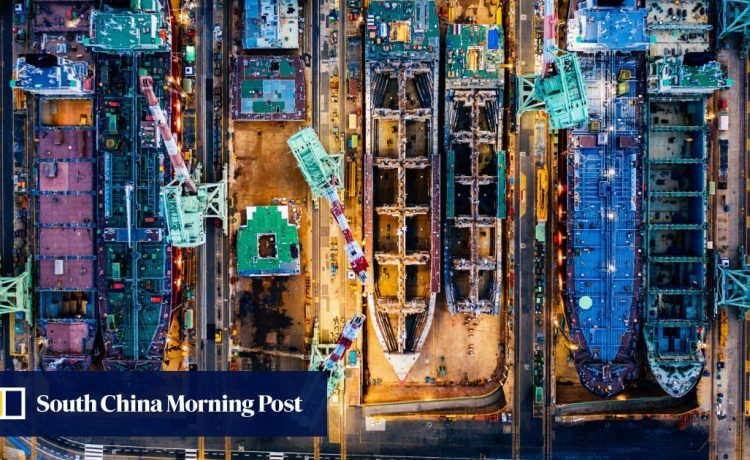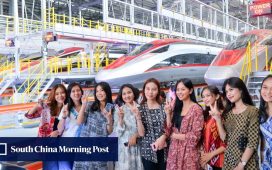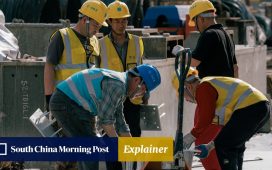“Chinese firms aiming to move up the value chain will have to turn to somewhere else to seek the know-how,” said Li Zhenghao, a senior surveyor with the Shanghai office of ship-classification agency Korean Register.
China’s LNG expansions reflect critical push to maintain energy security
China’s LNG expansions reflect critical push to maintain energy security
He was speaking in Shanghai last week at Marintec China, a maritime conference and exhibition that was attended by hundreds of international marine firms, including Korean shipyards.
Shipbuilding is a pillar industry of South Korea. Its dominance in the high-end sector, however, is facing mounting challenges from China, which has already outpaced its neighbour in many general manufacturing sectors by embracing low-cost strategies and technological innovation.
Carl Martin, a technical researcher with MRC Inc, a Busan-based maker of hi-tech navigation and communications equipment for various sea vessels, said Chinese shipyards have more capacity for mainstream bulk and container vessels, but Korean builders have more of the necessary skills to build LNG tankers and more eco-friendly vessels.
“It makes the two nations a perfect pair that can serve the global shipbuilding sector,” he said at the expo. “All players want to develop sophisticated vessels, and my experience with Chinese engineers is that they move quickly up the learning curve.”

Industry insiders also point to de facto tech-export restrictions that Seoul enacted in late 2020. The restrictions, part of a list of core technologies compiled by the Korean Ministry of Trade, Industry and Energy, covered high-value-added vessels such as super-container ships, low-temperature liquefaction tankers such as LNG tankers, large cruise ships, and vessels that use electric-propulsion systems.
They also included advanced engines; propulsion and automation systems; and core ship-material-manufacturing technologies.
Korean shipbuilders have largely pulled out of their Chinese factories – Samsung Heavy Industries closed its factory in Ningbo, Zhejiang province, two years ago and sold another China factory in Rongcheng, Shandong province, earlier this year. Bilateral exchanges of tech and cooperation in the field is very limited.
Last week, China’s vice-minister for commerce, Wang Shouwen, and South Korea’s trade minister, Ahn Duk-geun, met in Beijing and agreed to establish a dialogue mechanism on export controls and to activate a hotline for supply chains of major industry items. But details about the talks, such as whether they involved semiconductors or shipbuilding, were unavailable.
We must admit that Korean firms are still leading in design, model development, standard-setting
Last year, Korean shipyards delivered 89 per cent of the world’s new LNG and large crude carriers with capacities of more than 250,000 deadweight tonnage, according to South Korea’s trade ministry.
However, Chinese builders excel in annual deliveries and order intake. Data from maritime consulting firm Clarksons shows that global ship-order volume was 38.03 million compensated gross tonnages (CGT) in the first 11 months of 2023, or 1,746 ships if converted into standard ship tonnages. China bagged the lion’s share with 21.89 million CGT, or 995 ships, while Korea’s orders slumped 39 per cent, year on year, to 9.55 million CGT, or 201 ships.
Zeng Ji, a professor of ocean science and engineering with Shanghai Maritime University, said China is developing its own technologies for home-grown LNG ships.
“We must admit that Korean firms are still leading in design, model development, standard-setting, construction management and branding and marketing,” Zeng said. “However, the manpower shortage [in South Korea] is a big drag.”
As South Korea and Japan tilt to US, economic ties with China present dilemma
As South Korea and Japan tilt to US, economic ties with China present dilemma
The manpower crunch was earlier mentioned by Clarksons, despite Samsung, HD Hyundai, Daewoo and Hanwha being inundated with orders.
Hu Shimin, a transport analyst with Beijing-based Citic Securities, said in a note that Korea’s production woes presented opportunities for Chinese shipyards to catch up, because China has growing market demand for huge LNG tankers, and there is room for it to advance in value chains and green shipping initiatives.
Christian Damsgaard, head of naval architecture at Danish ship-design company Knud E. Hansen, argued that when the world is facing a production bottleneck amid a green transition, competition should give way to collaboration.
“Builders from both countries can thrive when the industry is in a boom,” he said at the Shanghai fair.







